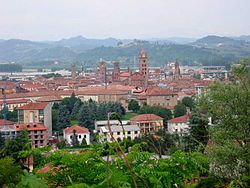Alba (CN)
|
Alba Alba pompeia |
||
|---|---|---|
| Comune | ||
| Città di Alba | ||

View of the city of Alba
|
||
|
||
| Location of Alba in Italy | ||
| Coordinates: 44°42′N 08°02′E / 44.700°N 8.033°ECoordinates: 44°42′N 08°02′E / 44.700°N 8.033°E | ||
| Country | Italy | |
| Region | Piedmont | |
| Province / Metropolitan city | Cuneo (CN) | |
| Frazioni | Altavilla, Gallo, Madonna di Como, Mussotto d'Alba, Piana Biglini, San Rocco Cherasca, San Rocco Seno d'Elvio, Santa Rosalia, Scaparone | |
| Government | ||
| • Mayor | Maurizio Marello (since June 23, 2009) | |
| Area | ||
| • Total | 54 km2 (21 sq mi) | |
| Elevation | 172 m (564 ft) | |
| Population (31 December 2011) | ||
| • Total | 31,667 | |
| • Density | 590/km2 (1,500/sq mi) | |
| Demonym(s) | Albesi | |
| Time zone | CET (UTC+1) | |
| • Summer (DST) | CEST (UTC+2) | |
| Postal code | 12051 | |
| Dialing code | 173 | |
| Patron saint | St. Lawrence | |
| Saint day | August 10 | |
| Website | Official website | |
Alba (Latin: Alba Pompeia) is a town and comune of Piedmont, Italy, in the province of Cuneo. It is considered the capital of the UNESCO Human Heritage hilly area of Langhe, and is famous for its white truffle, peach and wine production. The confectionery group Ferrero is based there.
Alba's origins date from before the Roman civilization, connected probably to the presence of Celtic and Ligurian tribes in the area.
The modern town occupies the site of ancient Alba Pompeia, the name given after being officially recognized as a town by the Roman consul Gnaeus Pompeius Strabo while constructing a road from Aquae Statiellae (Acqui) to Augusta Taurinorum (Turin). Alba was the birthplace of Publius Helvius Pertinax, briefly Roman emperor in 193.
After the fall of the Western Empire, the city was repeatedly sacked by Ostrogoths, Burgundians, Byzantines, Lombards, Franks, Hungarians and Saracens. In the 11th century it became a free commune (or city-state) and was a member of the Lombard League. Montferrat and the Visconti fought over the town; later it became a possession of the Gonzaga. Charles Emmanuel I of Savoy conquered it twice, while later France and Spain battled for its possession. The Treaty of Cherasco (1631) assigned Alba definitively to Savoy. During Napoleonic Wars, it was part of the Republic of Alba (1796) and of the Subalpine Republic, both French clients, before being annexed to the French Empire in 1802. It was an arrondissement center in firstly Tanaro department between 1802-1805, later in Stura one between 1805-1814 before liberation by Austrian troops. It was returned to Kingdom of Sardinia (Duchy of Savoy's name after gaining Sardinia in 1720) in 1814.
...
Wikipedia


